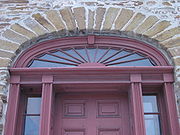
Fanlight
Encyclopedia

Glazing
Glazing, which derives from the Middle English for 'glass', is a part of a wall or window, made of glass. Glazing also describes the work done by a professional "glazier"...
bars or tracery
Tracery
In architecture, Tracery is the stonework elements that support the glass in a Gothic window. The term probably derives from the 'tracing floors' on which the complex patterns of late Gothic windows were laid out.-Plate tracery:...
sets radiating out like an open fan
Fan (implement)
A hand-held fan is an implement used to induce an airflow for the purpose of cooling or refreshing oneself. Any broad, flat surface waved back-and-forth will create a small airflow and therefore can be considered a rudimentary fan...
, It is placed over another window or a doorway. and is sometimes hinged to a transom
Transom (architectural)
In architecture, a transom is the term given to a transverse beam or bar in a frame, or to the crosspiece separating a door or the like from a window or fanlight above it. Transom is also the customary U.S. word used for a transom light, the window over this crosspiece...
. The bars in the fixed glazed window spread out in the manner a sunburst
Sunburst (design)
A Sunburst is a design or figure commonly used in architectural ornaments and design patterns. It consists of rays or "beams" radiating out from a central disk in the manner of sunbeams. Sometimes part of a sunburst, a semicircular or semi-elliptical shape, is used...
. It is also called a "sunburst light".
A chiefly British use of the word is to mean "transom
Transom (architectural)
In architecture, a transom is the term given to a transverse beam or bar in a frame, or to the crosspiece separating a door or the like from a window or fanlight above it. Transom is also the customary U.S. word used for a transom light, the window over this crosspiece...
".

